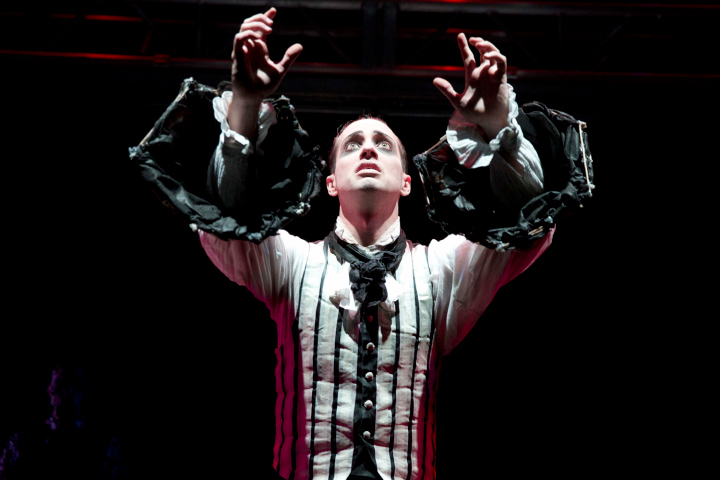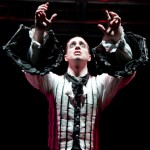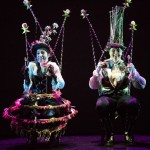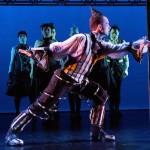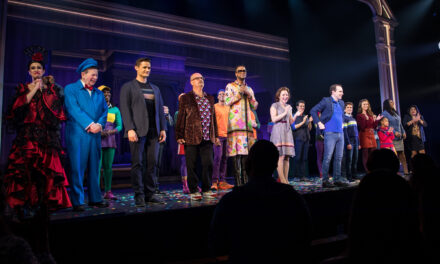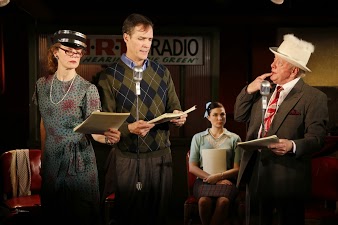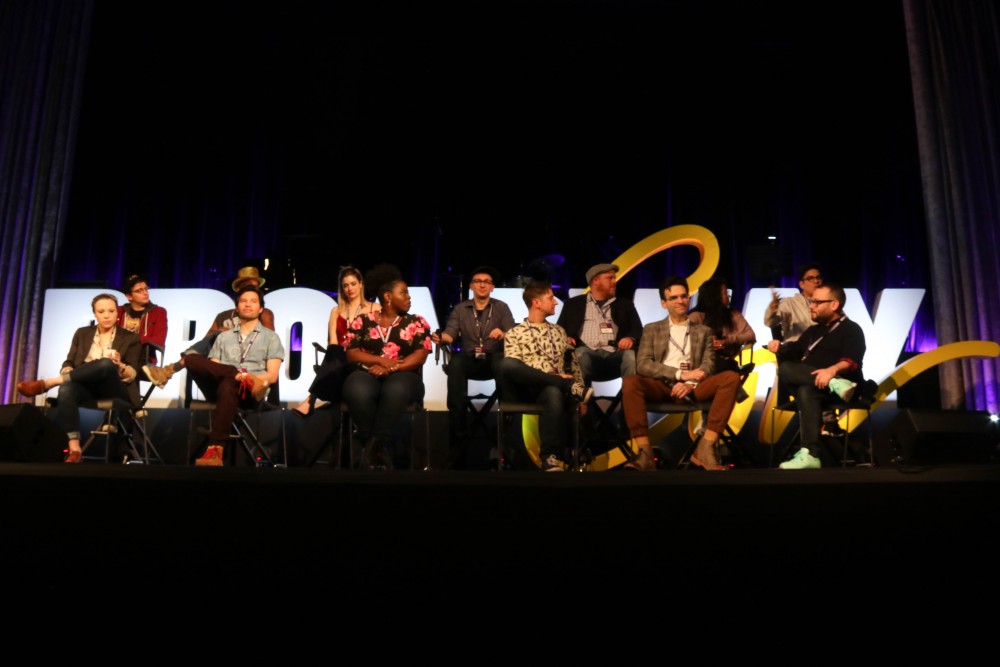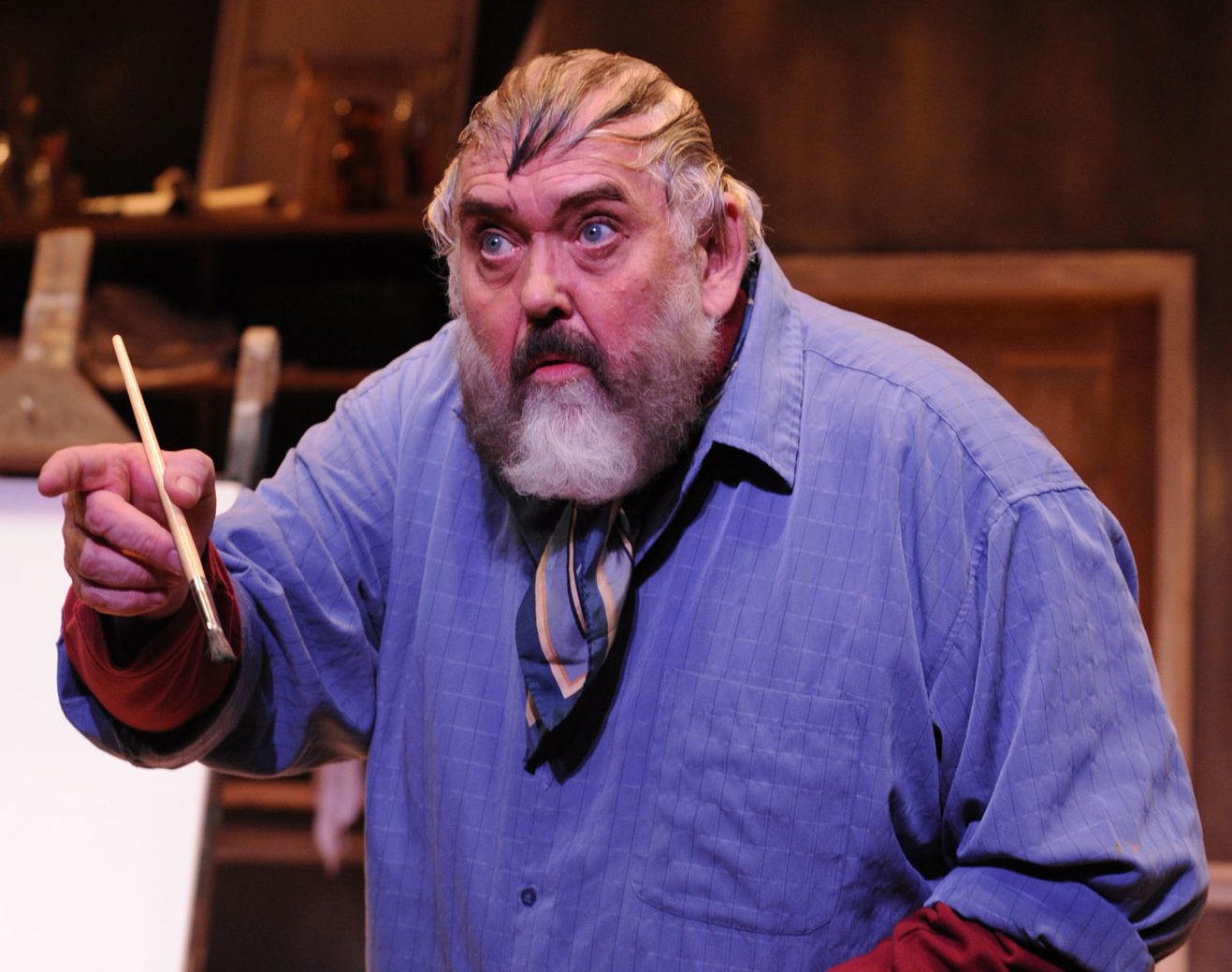Review by Samuel L. Leiter
As the old song goes, “Into each life some rain must fall,” but judging by the ups and downs of Edgar Allan Poe’s life—almost all downs—as limned in this quirky, murky new musical, some lives see nothing but storms. If you’re old enough to remember the character of Joe Btfsplk in the “L’il Abner” comics—the guy with a cloud perpetually over his head—you’ll know what I mean. For the second time in less than a year, Poe’s miserable life and death have been turned into a pseudo-avant garde musical (the other was last May’s Red-Eye to Havre de Grace); it’s about time the theatre wrote R.I.P. on this benighted writer’s life.
It’s fortunate that Nevermore: The Imaginary Life and Mysterious Death of Edgar Allan Poe, written, composed, and directed by Jonathan Christenson (who first did it for Canada’s Catalyst Theatre), is inventively conceived, directed, choreographed (by Laura Krewski), and designed (by Bretta Gerecke), as well as brilliantly performed by a versatile seven-member ensemble, mostly from Canada; it’s unfortunate that, once the stylistic premise is established, the piece rarely varies from it, providing an overlong two hours and twenty minutes in which the grim tone remains repetitively hallucinatory and phantasmagoric. One act and the show would need no more; two acts and it becomes a bore.
Nevermore imagines that, after Poe (the excellent Scott Shpeley) encounters a theatrical troupe while traveling on a steamer headed for New York, the actors decide to act out his life, with each playing multiple roles and with Poe playing himself. Everything is expressionistically theatrical, each movement carefully staged and timed, each vocal inflection calculated.
The players depict Poe’s unhappy childhood; his alcoholic father (Garett Ross); the death of his actress mother, Eliza (Lindsey VanWinkle), from TB; his separation from his beloved brother, Henry (Gaelan Beatty), and sister, Rosalie (Beth Graham); the insanity and suicide of Fanny Allan (Graham), his loving, adoptive mother; the penuriousness of his adoptive Scottish stepfather, Jock (Ross); his broken love affair with the strange Elmira (Shannon Blanchet); Henry’s death from TB; a scandal that nearly wrecked his career; his wife, Sissy’s (Graham), demise from TB; his alcoholism, etcetera and so on, including the unsolved circumstances surrounding his death. Throughout, the relations between Poe’s poems and stories and his life are referenced.
There’s an abundance of actual singing and a minimum of straight speech; many lines are delivered to heavily rhythmic accompaniment as the actors strike odd poses, like something out of Vakhtangov or Meyerhold in 1920s Soviet theatre. Christenson seems to have incorporated the thumping meters of Poe’s sharply rhymed poetry into his lyrics, so it’s only natural that the eleven o’clock number is a loudly throbbing rendition of Poe’s most famous poem, “The Raven,” performed by Poe and the ensemble.
The bizarre costumes—dominated by black and white—are surrealistic re-imaginings of mid-nineteenth-century garments and hats (one as large as a kite), the Tim Burton-like makeup tends toward the ghostly (Poe looks more like an anemic vampire than a human), and the men’s hair rises in numerous punk-like spikes; Poe himself has only a single, Fuji-like peak. Props, like Poe’s huge book and pen, have off-kilter dimensions, and there are vastly oversized masks, notably those suggesting ravens (they look more like dinosaur heads) in “The Raven.”
The performance is framed by a metal grid into which is set a series of sliding transparent panels allowing for rapid scene shifts and effective lighting, but establishing a shallow downstage acting area that forces the actors into two-dimensional arrangements. Too much of the lighting sticks to illuminating the actors from below, suggesting old-time footlights while giving everything a nightmarish glow.
Parts of this offbeat endeavor are memorable, but it remains more an exercise in style than a meaningful investigation into Poe’s creative genius. Nevermore had a brief run in New York at the New Victory Theatre in 2010, so this is a return visit; its relentless adherence to the mood of midnight dreary, however, only made me weak and weary, searching when it ended for the theatre’s door, thinking, as I went, “Nevermore.”
Nevermore: The Imaginary Life and Mysterious Death of Edgar Allan Poe
New World Stages www.nevermoreshow.com
340 W. 50th Street, NYC
Open-ended run
Photos: Joan Marcus


